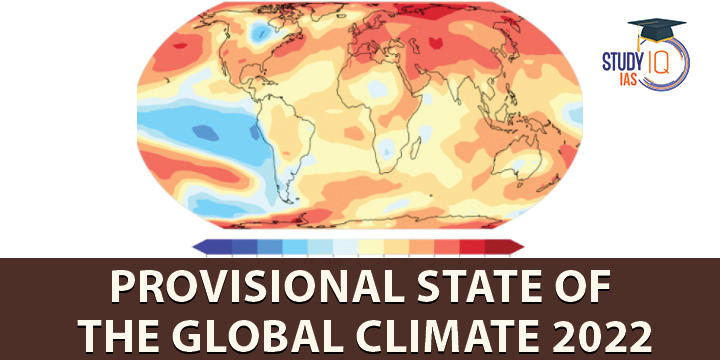Table of Contents
Provisional State of the Global Climate 2022
- It is an annual publication by the World Meteorological Organization (WMO).
- The report uses several climate Indicators to describe the changing climate—providing a broad view of the climate at a global scale.
Highlights of State of the Global Climate
Report:
Atmosphere
- Greenhouse Gases: Increasing levels of greenhouse gases in the atmosphere due to human activities are a major driver of climate change.
- Carbon dioxide (CO2): Atmospheric CO2 reached 149% of the pre-industrial level in 2021, primarily because of emissions from the combustion of fossil fuels and cement production.
- Methane: In 2021, methane concentrations reached 1908 parts per billion (ppb), a 262% increase over pre-industrial levels. This was the highest increase on record in a year.
- Nitrous oxide: In 2021, nitrous oxide reached 334 ppb, a 124% increase over pre-industrial levels.
Land
- Global Mean Surface Temperature (GMST): As greenhouse gas concentrations rise, so does global mean surface temperature (GMST).
- GMST in 2022 is currently estimated to be 1.15 ± 0.13 °C above the pre-industrial baseline (1850-1900).
- The eight years 2015 to 2022 are likely to be the eight warmest years on record.
- Despite La Niña conditions keeping global temperature low for the second consecutive year, 2022 is still likely to be 5th or 6th warmest year on record.
- Precipitation: Compared to temperature, precipitation is characterized by higher spatial and temporal variability, the report noted.
- Rainfall Surplus: In 2022, large areas with above normal precipitation included large parts of Asia, the Maritime Continent, Australia, New Zealand, areas of northern South America, the Caribbean, west Africa, Sudan, coastal areas extending from western Libya to Egypt, and the southern Arabian Peninsula.
- Rainfall Deficit: Meanwhile, regions with rainfall deficit included Europe, Central Asia, Northern Australia, Eastern Africa, most of North Africa, central and southern South America, and central and western North America.
- Indian Subcontinent: The majority of the Indian Subcontinent received high precipitation totals and the monsoon extended farther westward then usual towards Pakistan.
Ocean
- Ocean Warming:
- Around 90% of the excess heat that accumulates in the earth system due to increasing concentrations of GHGs, goes into the ocean.
- As per the report, ocean warming rates show a particularly strong increase in the past two decades.
- It is expected that the ocean will continue to warm well into the future.
- Marine Heatwaves (MHW):
- Overall, 55% of the ocean surface experienced at least one MHW during 2022 – the lowest annual coverage since 2012 (57%).
- In the Arctic, the Laptev and Beaufort Seas experienced severe and extreme MHWs.
- Sea Level Rise:
- Sea level continued to rise in 2022, reaching a new record high.
- Since January 2020, global mean sea level has risen by nearly 10mm, approximately 10% of the overall rise.
- Ocean Acidification:
- The ocean absorbs around 23% of the annual emissions of anthropogenic CO2 to the atmosphere.
- Global mean ocean pH has been steadily declining at rates not seen for at least the past 26,000 years.
Cryosphere
- Sea Ice Extent: It is defined as the area of ocean where at least 15 percent of the surface is frozen. It serves as a useful indicator of climate change.
- Arctic Sea Ice: In 2022, Arctic sea-ice extent was below the long-term average for most of the year.
- Antarctic Sea Ice: It dropped to 1.92 million sq.km in February 2022, the lowest level on record and almost 1 million sq.km below the long-term (1981-2010) mean.
- Greenland Ice Sheet: The Greenland Ice Sheet ended with a negative total mass balance for the 26th year in a row.
- Glacier Mass Balance:
- From 2020-2021, the glaciers with long-term observations experienced an average mass balance of –0.77 m water equivalent (m w.e.).
- Swiss Alps: In Switzerland 6% of the glacier ice volume was lost between 2021 and 2022.
Ecosystems
- Ecosystem degradation: Ecosystems are degrading at an unprecedented rate, limiting their ability to support human well-being and harming their adaptive capacity to build resilience.
- Mountain Ecosystems:
- Mountain ecosystems are vulnerable and can be profoundly affected by climate change due to their low capacity to adapt.
- Climate change may exacerbate water stress, especially in areas of decreased precipitation and where groundwater is already being depleted.
- Biodiversity Loss & Extinction:
- Substantial changes in species’ abundance and distribution may in turn affect the interactions between species.
- Arctic Ecosystems
- Climate change is triggering the disintegration of the Greenland and Antarctic ice sheets and increasing the chances of the Arctic Ocean being ice-free in the summer, further disrupting ocean circulation and Arctic ecosystem.
- Coastal & Marine Ecosystems:
- Rising temperatures heighten the risk of irreversible loss of marine and coastal ecosystems, including seagrass meadows and kelp forest.
- Coral reefs are projected to lose between 70 and 90% of their former coverage area at 1.5 °C of warming and over 99% at 2 °C.
Risks and Impacts of Changing State of the Global Climate 2022
- Extreme events: Rising global temperatures have contributed to more frequent and severe extreme weather events around the world.
- Ex: Heatwaves in India & Pakistan.
- Food security: As of 2021, 2.3 billion people faced food insecurity, corresponding to 9.8% of the global population. Rising undernourishment has been exacerbated by the compounded effects of COVID-19 on health, food security, incomes, and equality, as well as of protracted conflicts and violence.
- Ex: Drought in Horn of Africa.
- Displacement: Extreme weather events and conditions have had major and diverse impacts on population displacement and on the vulnerability of people already displaced throughout the year.
- Ex: Displacement due to flood in Pakistan and Bangladesh.
- Impacts on Sustainable Development: Rising atmospheric CO2 concentrations lead to cascading effects that contribute to high impact events, risking the achievement of the Sustainable Development Goals (SDGs).

























 WhatsApp
WhatsApp